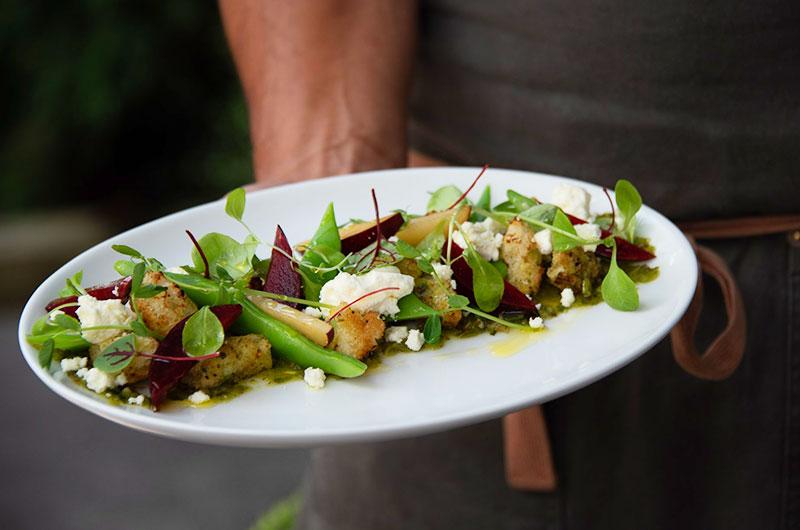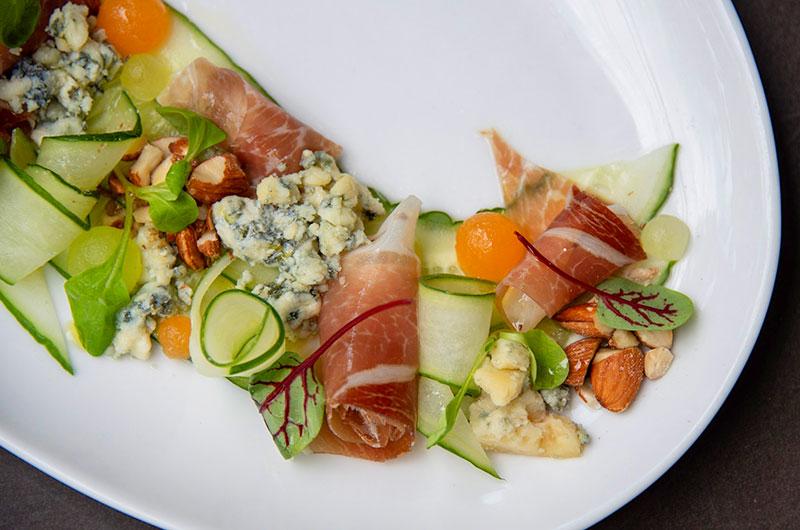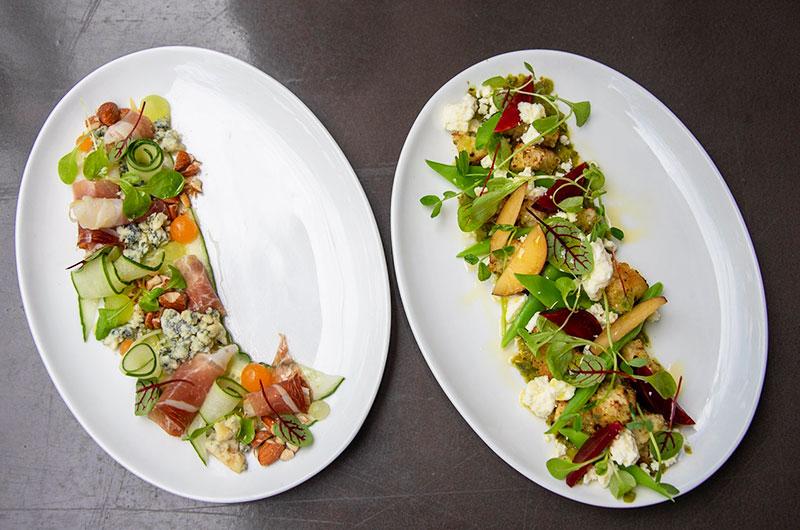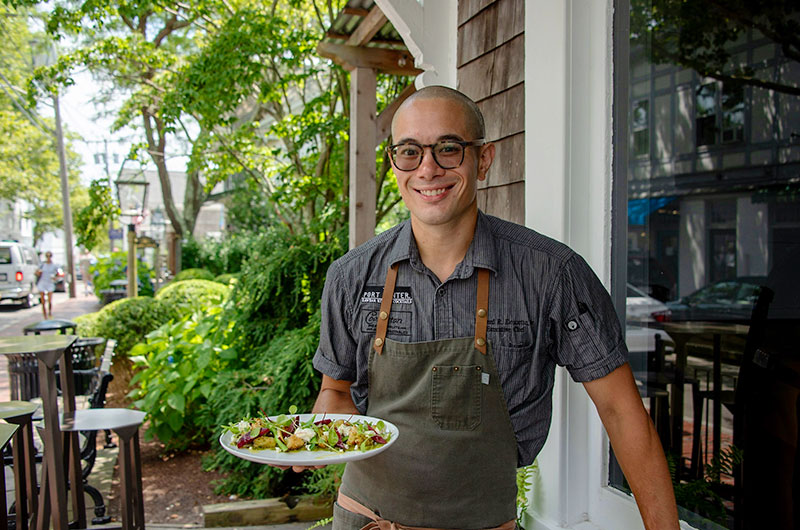My vegetable radar is always on. It’s not just juicy ripe tomatoes and freshly picked corn I’m trying to locate. It’s something less tangible. Call it inspiration, I guess. If I see a beautiful vegetable, discover a new flavor pairing, learn a new technique — all those things mean I can up my game when cooking vegetables at home.
My radar has not exactly had to work overtime to pick up the good vibes emanating from a restaurant a block away from the Gazette office. Yet I didn’t even know who the chef was when I spotted a dish of shishito peppers on the @thecovingtonrestaurant Instagram feed.
Here’s what the description under the photo said: “Our newest iteration of a Covington Classic: Blistered Shishitos. This summer we are serving these lovelies with a sundried tomato romesco, ricotta salata, pine nuts and the award-winning Ravece extra virgin olive oil.” Sounds good, right? And it looked gorgeous. But also, a tiny lightbulb went off in my head. I have grown shishito peppers, I have grilled them, I have scooted them around in a cast iron pan. And always I just sprinkle them with sea salt to finish. Seems like the romesco sauce alone would send them into new territory.

I scrolled through the Instagram feed, scrutinizing the food. Then there was a photo of the kitchen staff, and look — Chef Richard Doucette! I had interviewed him two summers ago at the Harbor View and now here he was, executive chef of both The Covington and The Port Hunter restaurants on Main street in Edgartown. (Richard also spent 10 years in Boston in both big and small restaurants including L’Espalier, the Mandarin Oriental and Taj.)
I went online to look at the Covington menu, scrolled down, and immediately loved the laconic descriptions of each dish, especially the small plates. They read like telegrams.
Mermaid Farm Panzanella: Plums. Romano Beans. Green Harissa. Torn Foccacia.
The Grey Barn Bluebird + Speck: Compressed Melon. Cucumber. Cress. Almonds.

Baba Ghanouj + Naan: Charred Eggplant. Peruvian Peppers. Za’atar. House Naan.
Vineyard Kale Salad: MVM Shiitake Mushrooms. Lemon Vinaigrette. Parmesan.
Next, a phone call to the restaurant to see if I could schedule a quick chat with Richard about those shishitos and maybe another ingredient pairing or two.
The quick chat lasted 45 minutes and I came home with six sheets of yellow legal paper filled up, as well as a menu with notes scribbled all over it.

For a soft-spoken man, Richard Doucette sure has a lot to say.
On using as many local and seasonal ingredients as possible, he says, “You don’t have to do too much to an ingredient if it’s at its peak and it hasn’t traveled hundreds of miles.”
At first his mantra doesn’t seem that different from those of many local chefs. But Richard is really walking the walk. In addition to buying wholesale from local farms like North Tabor and Mermaid and Morning Glory, he (or Covington co-owner Ted Courtney) also goes to the farmers’ market every week to buy directly from smaller farmers who can’t afford to wholesale at this point.
Richard and his girlfriend Olivia Rabbitt, program coordinator for Island Grown Initiative, are tending a garden. Olivia also lets Richard know what’s peaking at the Island Grown Farm Hub, from strawberries and sorrel in the greenhouse to sour cherries and stone fruit in the maturing orchard. Together they forage for watercress, blueberries and black raspberries.
Richard is an avid fisherman too, so he knows what the Vineyard fleet is bringing in. He gets most of his fish from the Menemsha Fish House, and points out that both the Covington and the Port Hunter serve nothing but New England fish and shellfish.
I also learned, by the way, that The Covington has not one menu, but four: one for omnivores, one for vegans, one for vegetarians, and one with gluten-free dishes. And everything — everything, including the bread and the charcuterie — is handmade.
We were deep into our conversation about ingredients when I realized that Richard was delineating his approach to creating a dish in such a way that it could almost be a primer for home cooks. Hurrah.
Here’s what I gleaned:
• “What grows together goes together. That’s really true,” Richard said. Beets and Berries. Tomatoes and Peppers. Beans and Corn. If you’re at the farmers’ market, don’t be shy, he says. Talk to the farmers about what they’re harvesting right now and what’s coming up. If you don’t find exactly what you thought you were looking for, push out of your comfort zone and try something different.

• Palette and Palate. “I associate colors with taste. Similar colors go together,” he says, mentioning a summer salad of yellows and bright greens that brings together lemon cucumbers, tomatillos, and green zebra tomatoes — along with fresh mozzarella and fresh basil — for a green spin on a caprese salad.
• Quality ingredients make a huge difference. Richard sources an intensely flavorful southern Italian extra virgin olive oil from a small importer in Malden. (I always recommend that home cooks do their own olive oil “tasting” to see how different brands are and to find one to cook with every day and one to splurge on when it matters.)
• Give every dish its own personality. Finding a balance of flavors — sweet, spicy, savory — and adding texture are important goals (“eggplant needs something crunchy”), but so is adding one strange note. “You may have something good, but to lift it to something special, you need that one note that makes people say, ‘where did that come from?’”
• Collaborate with your fellow cooks and eaters. Get feedback. Dishes evolve, Richard points out, always moving towards perfection. “Until you get there and then you start all over again with something else.”
A few days later when I returned with photographer Jeanna Shepard to photograph Richard, he made both the Mermaid Farm Feta Panzanella and The Grey Barn Bluebird + Speck for us to taste. They were so beautiful to look at that I hesitated to plow my fork through them. But only for a moment. Those plates weren’t precious; they were inviting. And every bite had color and flavor and texture and personality. And just one thing that I couldn’t quite put my finger on.







